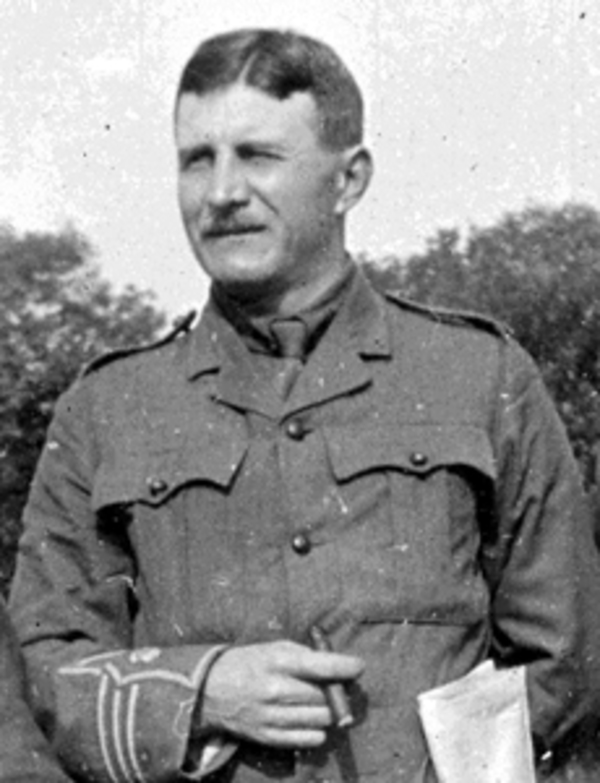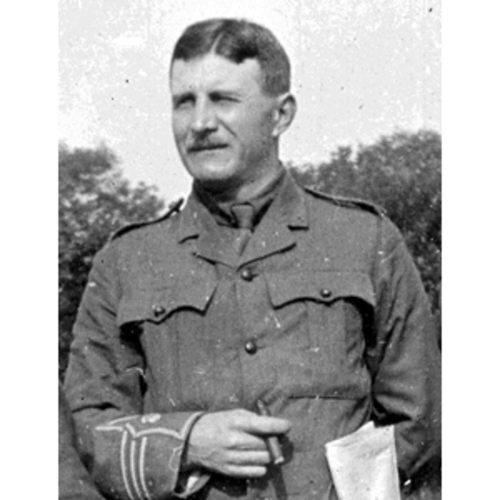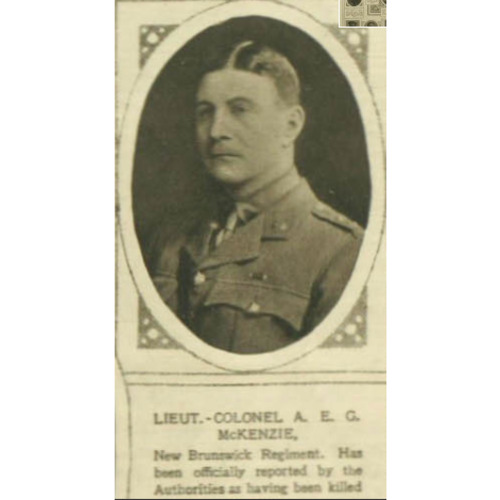
Source: Link
McKENZIE, ARCHIBALD ERNEST GRAHAM, teacher, lawyer, and militia and army officer; b. 21 Jan. 1878 in Campbellton, N.B., son of Archibald McKenzie, an mha and collector of customs, and Jane Elizabeth Smith; m. 28 Dec. 1904 Charlotte Bishop Troy (d. 1949) in Newcastle, N.B.; they had no children; d. 28 Aug. 1918 near Arras, France.
Ernest McKenzie was very much a product of his Scots Presbyterian background, where education, discipline, and hard work were the norm. On completing high school, he attended the Normal School in Fredericton (1894–95). He then taught for four years and in 1899 matriculated at the University of New Brunswick. Tall and robust, he was a first-class athlete and an accomplished intercollegiate debater and model parliamentarian. After taking his ba in 1902, he became principal of Harkins Academy in Newcastle and while there he obtained his ma degree. In 1905 he moved to Saint John, where he taught at the Albert School, attended classes at the Saint John Law School, and completed his articling with John Babington Macaulay Baxter*. He received his bcl in 1907 and opened a law office in Campbellton.
There can be little doubt that McKenzie was ambitious and sought a role in public life. He soon built up a busy practice, became town solicitor, and was extremely active in local affairs, serving on the council of the Board of Trade and the executives of sporting and other clubs. An active mason, he became master of the Campbellton lodge in 1911 and an officer of the New Brunswick Grand Lodge in 1912. Ern, as he was known, and Lottie were also part of the local social scene. In addition, McKenzie rose to prominence in the Liberal party and regularly employed his talent for rousing platform oratory in federal and provincial election campaigns. His popularity led to his selection as a candidate for Restigouche in the 1912 provincial election; however, he was unable to overcome the Conservative party’s landslide victory under James Kidd Flemming*.
McKenzie was also a member of the militia, having enlisted in 1899. He exemplified the new professional attitudes that the militia was nurturing as it grew and modernized in the period after the South African War [see Sir Frederick William Borden]. Commissioned in the 73rd (Northumberland) Regiment in 1901, McKenzie was promoted lieutenant in 1904 and captain in 1907; he became adjutant of the regiment in May 1914.
On the outbreak of World War I in August McKenzie volunteered for service overseas. Following the departure of the first Canadian contingent that fall, the formation of a second was authorized, with a battalion recruited from New Brunswick. In testimony to his abilities, McKenzie was appointed second in command of the 26th Battalion with the rank of major. The unit left for England in June 1915 and arrived in France in September. The only New Brunswick infantry battalion to serve continuously in France and Belgium throughout the war, the 26th gained a reputation for dependability as it took part in the major battles of the Canadian Corps and its achievements, followed closely at home, were a source of pride to the province.
McKenzie became acting commander of the unit in April 1916. Although he was somewhat severe by nature, his facility for hard work, strong personality, and penchant for leadership suited him to command in the field. Promoted lieutenant-colonel on 29 May, when he was confirmed in his command, he led from the front, shared the rigours of trench life with his men, and worked always for their welfare and the success of the battalion. In return he received their respect and cooperation and the battalion’s morale was high.
After McKenzie assumed command, the allies undertook a series of major offensives. Through the autumn of 1916 on the Somme in France, McKenzie handled the 26th with skill, particularly in the capture of Courcelette. His good work was recognized with the award of the Distinguished Service Order. At the close of the battle of Vimy Ridge in April 1917 the “Fighting 26th” was “alone in its glory” in a position 2,500 yards in advance of the Canadian Corps’s front on the Douai Plain, a position named New Brunswick Trench by army headquarters. (“May not this splendid exploit of our brave men,” exclaimed Premier Walter Edward Foster*, “be taken as a favorable omen of the advance of New Brunswick as a province.”) McKenzie subsequently attended a senior officers’ course in England and then returned to lead the battalion through the horrors of Passchendaele in November. By then, after two years of front-line service, he was exhausted and in late November he contracted paratyphoid fever. He rejoined the 26th in March 1918, healthy and refreshed, and at the battle of Amiens in early August 1918 its conduct was testimony to his leadership.
The allied advance continued with the battle of the Scarpe near Arras from 26 to 30 August. Fighting was bitter, and intense enemy fire caused heavy losses. Among those killed was Ernest McKenzie. His “very gallant conduct . . . utter disregard for danger . . . cool demeanour . . . [and] almost superhuman courage” as he led his men through “the most destructive fire” was brought to the attention of higher command by Padre Ronald Cameron MacGillivray, who was present during the attack, and recounted in the press back home. Lieutenant Alfred Johnson Brooks* reported that the men of his company were “deeply affected over the loss of their Colonel, to whom they were greatly devoted,” a sentiment that prevailed throughout the battalion. On 4 October McKenzie was awarded a bar to his DSO for skill, leadership, and courage at Amiens. His gallantry at Arras went unrecognized, however, except in the hearts of his men. As one of his officers recounted, “All his men say he died a hero.” He was buried in Wancourt British Cemetery, near Arras.
McKenzie was undoubtedly New Brunswick’s most distinguished soldier in World War I. Throughout the province, as in his regiment, his death was counted a great loss. Premier Foster referred in the Legislative Assembly to the bright prospects McKenzie had given up and said of him that “no soldier ever did better service for his country, and none will be more greatly missed.” McKenzie had been a man who sought to lead and who died as he had always lived, vigorous, busy, and fully committed to the tasks at hand. He personifies those many talented Canadians whose abilities were lost to their provinces and the country when they fell in the Great War.
[Information concerning Ernest McKenzie was kindly supplied to the author by Dr Stuart A. Smith of Keswick Ridge, N.B., in interviews on 5 and 12 Oct. 1995. j.l.w.]
A fine head-and-shoulders drawing of McKenzie done by Ralph Godard Mathews in 1916, possibly in London, is in the War Art Coll. at the Canadian War Museum, Ottawa; an entry for it appears in A check list of the war collections of World War I, 1914–1918, and World War II, 1939–1945, comp. R. F. Wodehouse (Ottawa, 1968), no.8427. In 1939 the former officers of the 26th New Brunswick Battalion commissioned an oil portrait of McKenzie, seated in uniform and wearing the ribbon of the DSO with rosette to indicate the bar. This portrait is held by the N.B. Museum at accession no.67.53.
NA, RG 9, III, 4850; RG 150, Acc. 1992–93/166. N.B. Museum, Canadian Expeditionary Force, 26th Infantry Battalion, war diaries, 1914–19. PANB, MC 288, MS4; RS 114, 11/23–28; RS 117, A2/3, book C; RS657, H3, K3, L3. Univ. of N.B. Library, Arch. and Special Coll. Dept. (Fredericton), UA RG 15 (Literary and Debating Soc. minutes), book 4 (1894–1903); RG 24 (Students’ records, marks, and tests), book 10 (1891–1902). Campbellton Graphic (Campbellton, N.B.), 1909–18. Events (Campbellton), 1903–8. North Shore Leader (Newcastle, N.B.), 20 Oct. 1939, 13 May 1949. Saint John Globe, 1915, 1918–19. St. John Standard (Saint John), 30 April 1915, 1917–19. Telegraph-Journal (Saint John), 9 April 1932, October 1939. A. L. Barry, Batman to brigadier ([Newcastle, 1965]). Can., Dept. of Militia and Defence, Militia list (Ottawa), 1901–14. R. W. Gould and S. K. Smith, The glorious story of the Fighting 26th . . . (Saint John, [1918]). S. D. MacGowan et al., New Brunswick’s “Fighting 26th”: a history of the 26th Battalion. C.E.F, 1914–1919 (Saint John, 1994). N.B., Legislative Assembly, Synoptic report of the proc., 1919. Nicholson, CEF. University Monthly (Fredericton), 1899–1904. G. F. Wallace et al., The Saint John Police story (2v. to date, Fredericton, 1991– ), 2.
Cite This Article
John L. Williamson, “McKENZIE, ARCHIBALD ERNEST GRAHAM,” in Dictionary of Canadian Biography, vol. 14, University of Toronto/Université Laval, 2003–, accessed December 29, 2025, https://www.biographi.ca/en/bio/mckenzie_archibald_ernest_graham_14E.html.
The citation above shows the format for footnotes and endnotes according to the Chicago manual of style (16th edition). Information to be used in other citation formats:
| Permalink: | https://www.biographi.ca/en/bio/mckenzie_archibald_ernest_graham_14E.html |
| Author of Article: | John L. Williamson |
| Title of Article: | McKENZIE, ARCHIBALD ERNEST GRAHAM |
| Publication Name: | Dictionary of Canadian Biography, vol. 14 |
| Publisher: | University of Toronto/Université Laval |
| Year of publication: | 1998 |
| Year of revision: | 1998 |
| Access Date: | December 29, 2025 |




